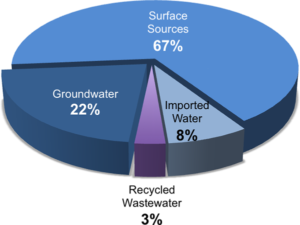A summary of the water management and use studies completed in Phase 2 is provided in Section 6.0 (798Kb PDF). See also Key Findings, or Section 19.0 of the Summary Report.
A total of 443,000 ML of water is licensed for withdrawal from surface sources for human use in the Basin.
Of this total, 163,000 ML is supported by storage.
Groundwater use does not require a licence.
Although there are over 4,000 licences to store or use surface water in the Basin, about 95% of the withdrawal licences – by volume – are held by 57 of the largest water suppliers.
Actual average annual water use in the Basin is 219,000 ML, derived from several sources (Figure 3).
The distribution of water used in the Basin is shown in Figure 4.
Indoor residential water use averages 150 L/person per day.
Outdoor residential water use averages 525 L/person per day year-round, i.e. more than 1,000 L/person per day during summer.

It is recommended that water suppliers measure and report their water extractions, and measure the water delivered to end-users.
It is recommended that water conservation measures in all water use sectors continue to be expanded and adopted throughout the Basin, and that water suppliers should preserve their opportunities to expand storage in upland reservoirs.
Project Downloads:
- Summary Report – Section 6.0 – Water Management and Use (798Kb PDF)

